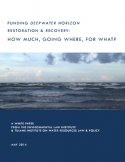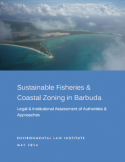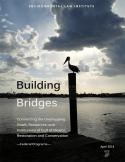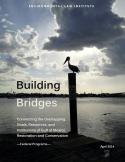
Research Reports
ELI publishes Research Reports available for free download that present the analysis and conclusions of the policy studies ELI undertakes to improve environmental law and policy. These reports contribute to education of the profession and disseminate diverse points of view and opinions to stimulate a robust and creative exchange of ideas. Those publications, which express opinions of the authors and not necessarily those of the Institute, its Board of Directors, or funding organizations, exemplify ELI’s commitment to dialogue with all sectors.
Recovering and restoring the Gulf of Mexico from the injuries caused by the disaster is an astoundingly complex undertaking. The processes that have been initiated to spur the assessment and treatment of various types of harm at various scales of action are accordingly complex. While it is unknown how much will ultimately be spent to recover the Gulf of Mexico from Deepwater Horizon, restoration and recovery funds are steadily accumulating from the parties responsible for the disaster.
Read More >
The Ocean Program supports Barbuda Blue Halo Initiative, which empowers Barbudans to restore their coastal waters by developing a science-based Sustainable Coastal Policy. ELI drafted the framework report to support sustainable fisheries and coastal zoining in Barbuda.
Read More >
On April 20, 2010, an explosion rocked the Deepwater Horizon mobile offshore drilling unit. Eleven crewmen lost their lives in the blast, and the rig burned for the next thirty-six hours. Then, forty-one miles off the southeast coast of Louisiana, the Deepwater Horizon sank. Back at the wellhead, a quarter-mile away and 5,000 feet beneath the surface of the Gulf of Mexico, the environmental disaster was just beginning.
Read More >
On April 20, 2010, an explosion rocked the Deepwater Horizon mobile offshore drilling unit. Eleven crewmen lost their lives in the blast, and the rig burned for the next thirty-six hours. Then, forty-one miles off the southeast coast of Louisiana, the Deepwater Horizon sank. Back at the wellhead, a quarter-mile away and 5,000 feet beneath the surface of the Gulf of Mexico, the environmental disaster was just beginning.
Read More >